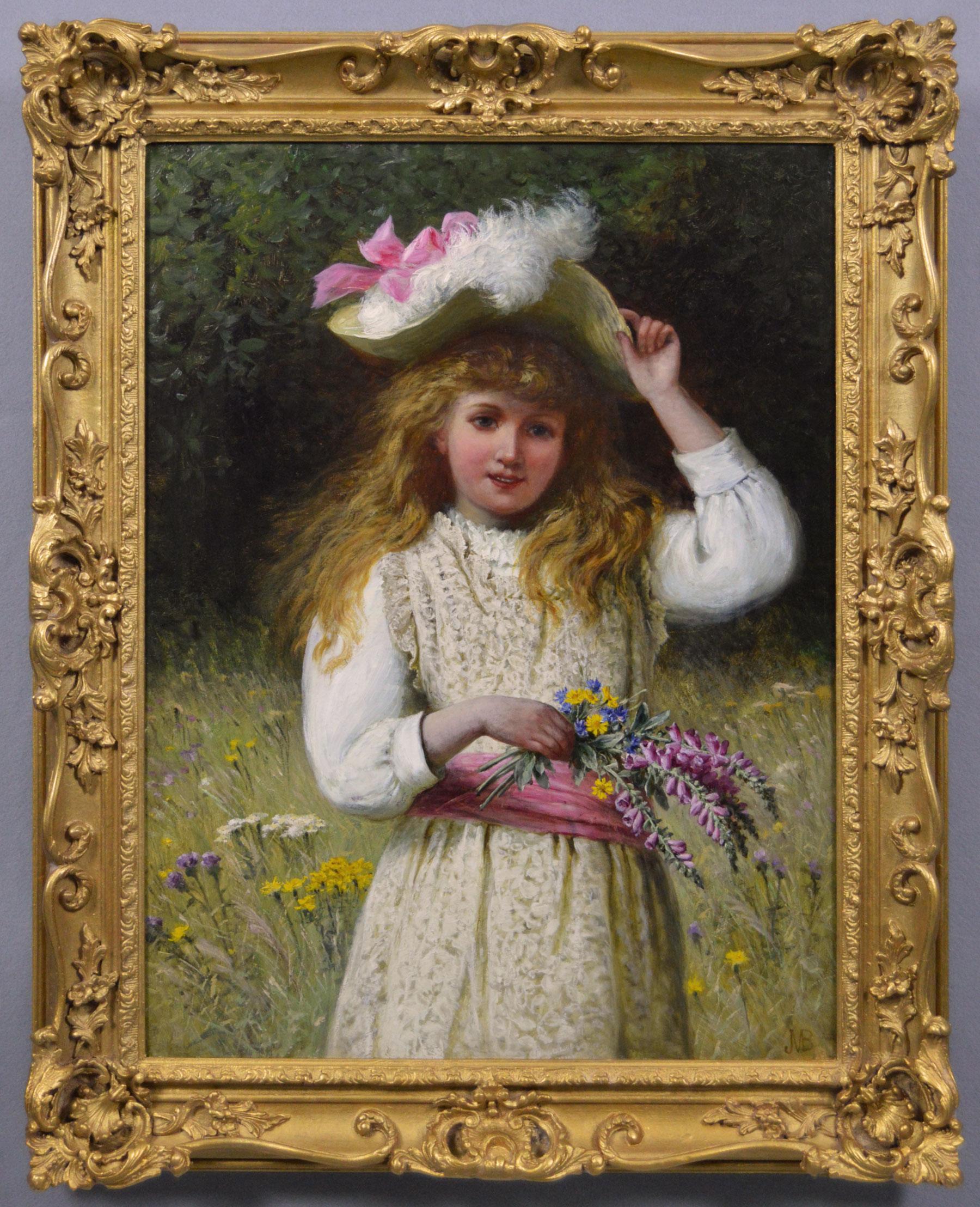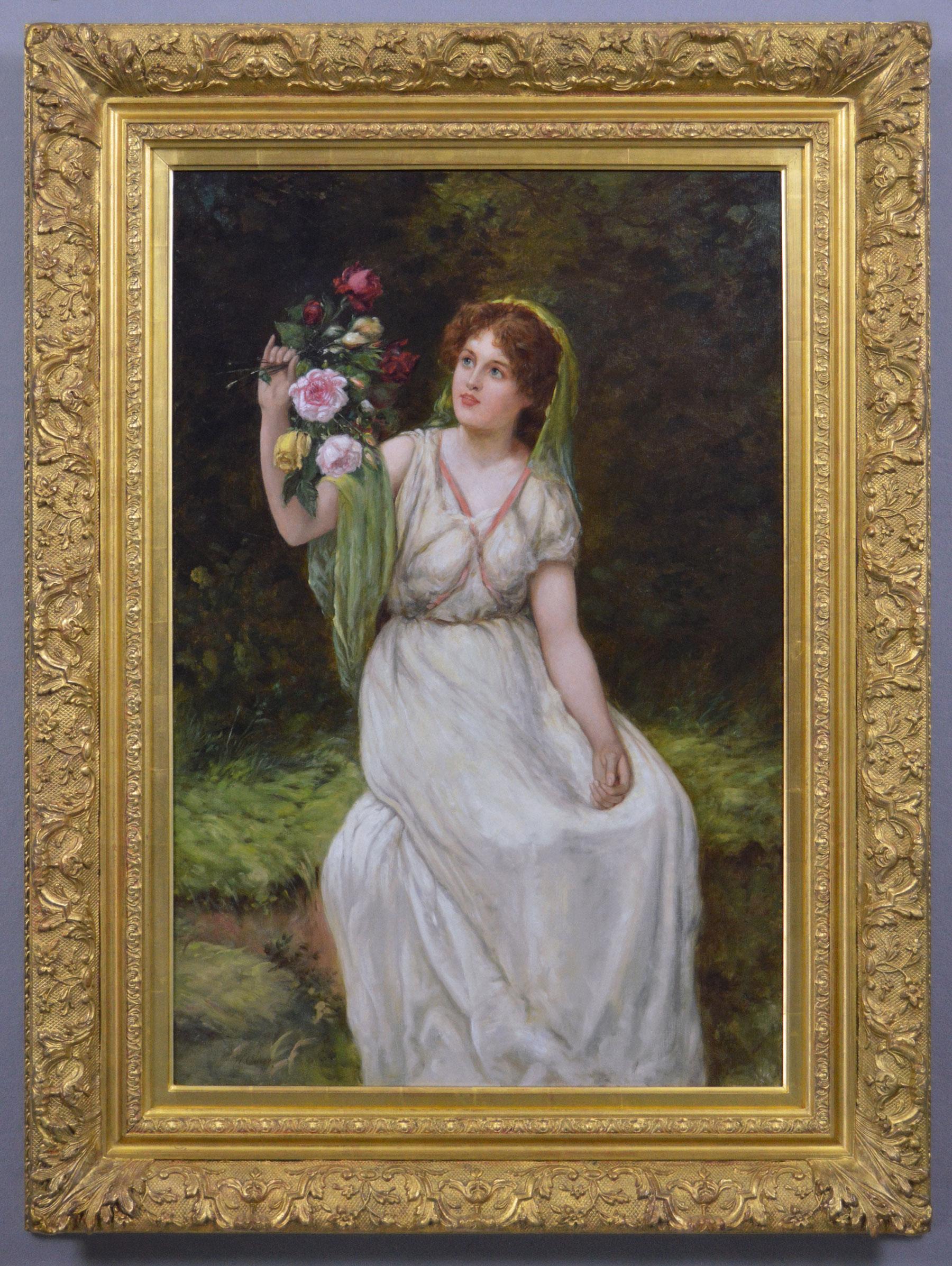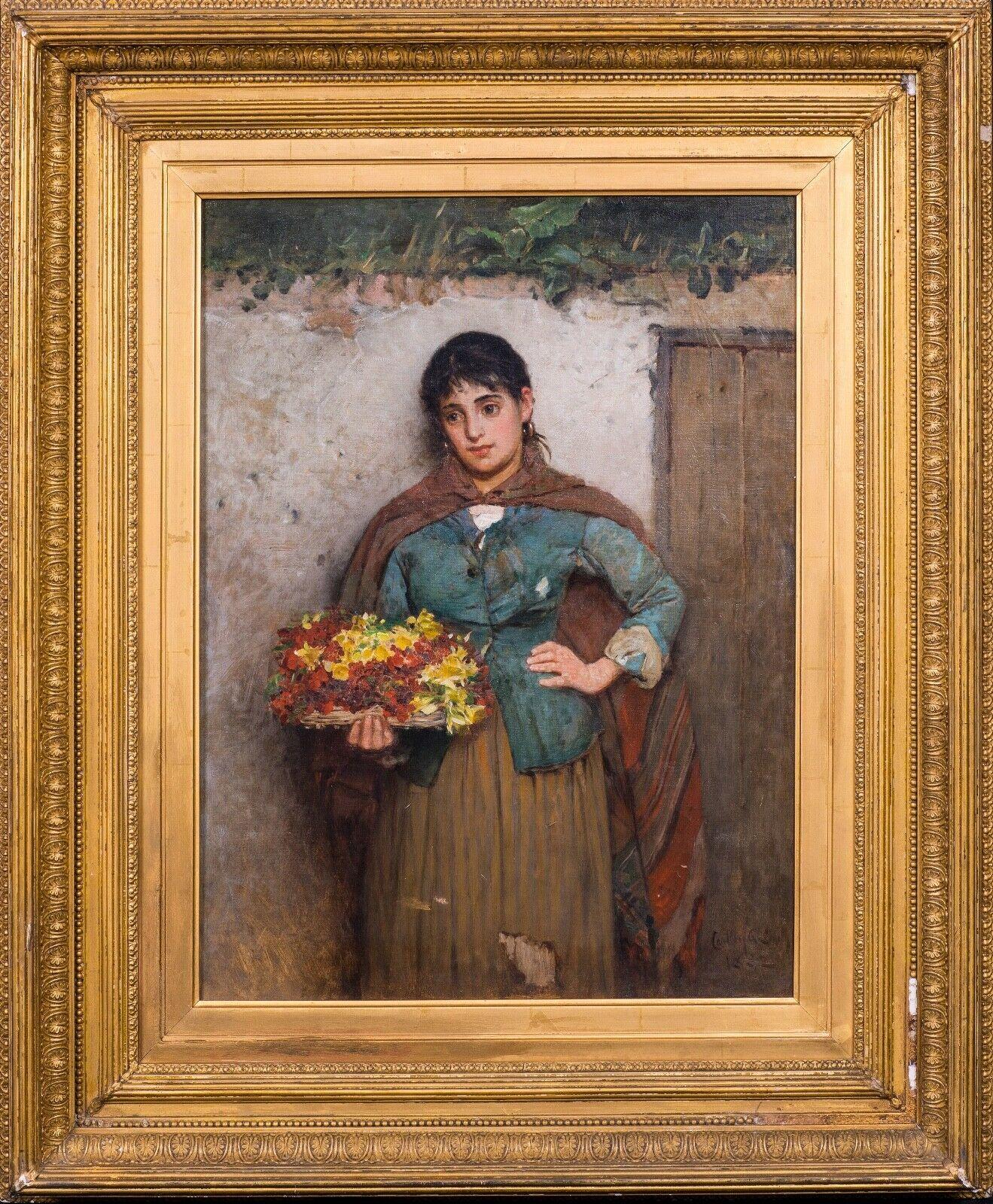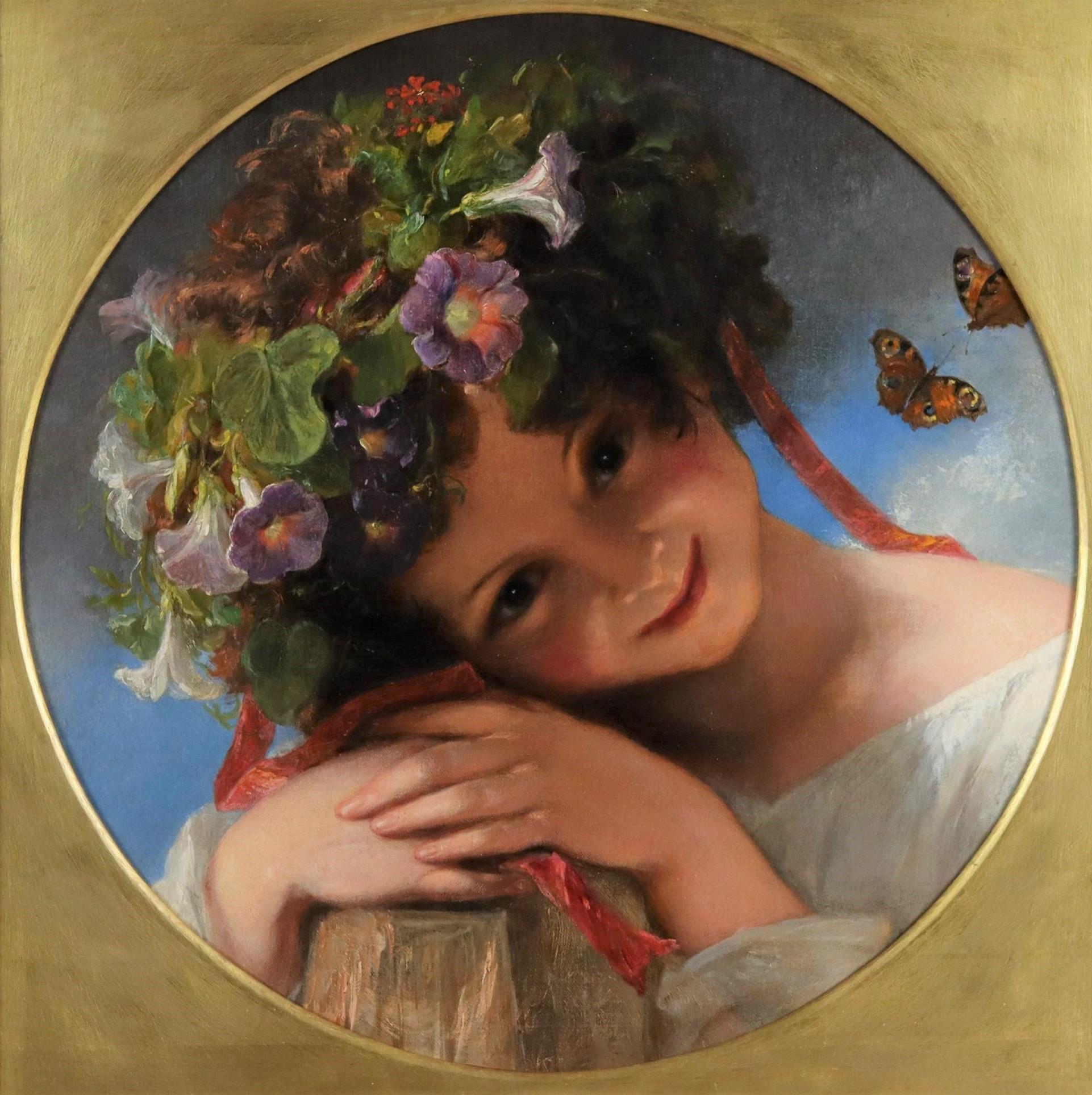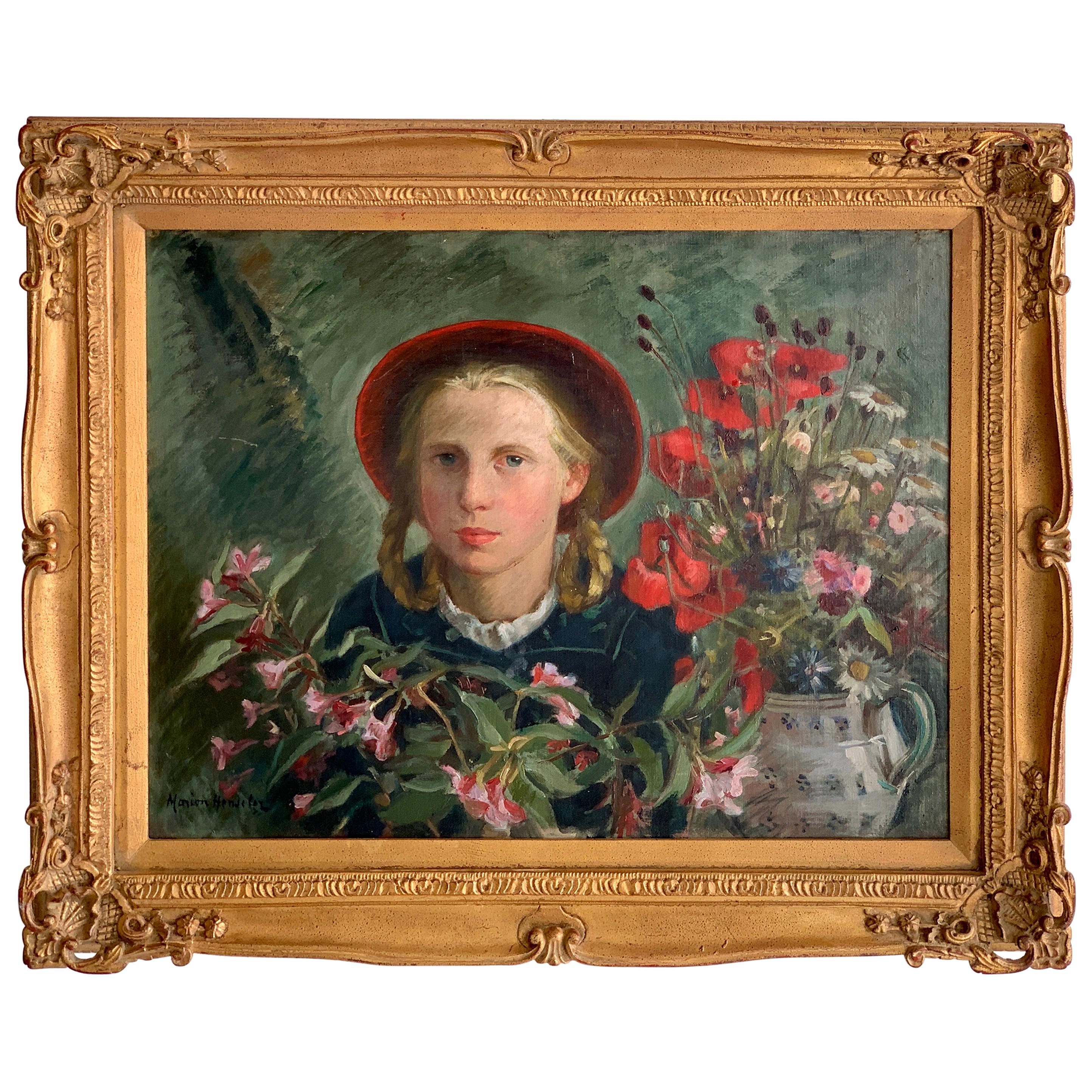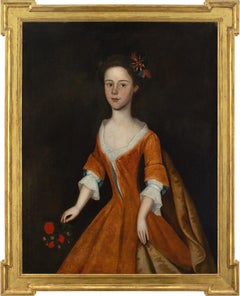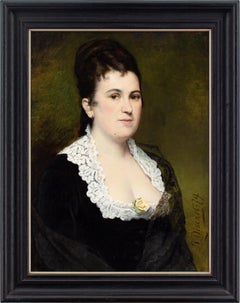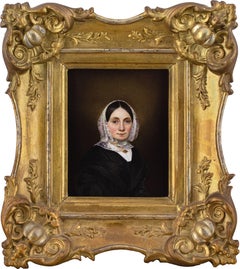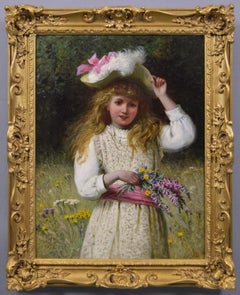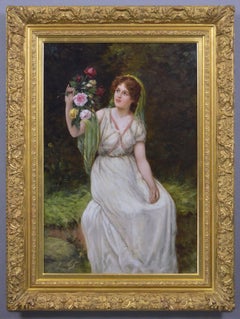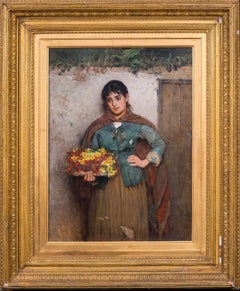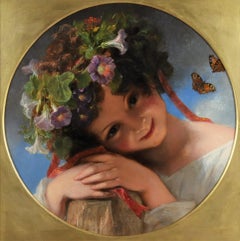Items Similar to Rowland Holyoake, Portrait Of A Girl With Wildflowers
Video Loading
Want more images or videos?
Request additional images or videos from the seller
1 of 14
Rowland HolyoakeRowland Holyoake, Portrait Of A Girl With Wildflowers1888
1888
$5,153.03
£3,740
€4,396.14
CA$7,130.51
A$7,861.22
CHF 4,112.74
MX$96,442.60
NOK 51,771.23
SEK 48,414.28
DKK 32,830.48
About the Item
This charming late 19th-century oil painting by British artist Rowland Holyoake (1861-1928) depicts a girl carrying wildflowers while wearing a straw hat decorated with the same. It was previously valued by Christie’s, London, at £5,000-£7,000. Holyoake was a Royal Academy trained painter of portraits, scenes and landscapes.
Clutching a freshly picked curated posy of spritely blooms, she’s perhaps looking across the garden for further additions. Her hat, adorned with delicate poppies and other flora, is decorated beautifully. She’s at home amid the resplendent delights of nature.
Born in London, Rowland Holyoake’s father was the distinguished figure painter, William Holyoake (1834-1894), a regular exhibitor at the Royal Society of British Artists (RBA) and a popular curator at Royal Academy Schools. Given this, it’s conceivable that, from an early age, the young man was taught the rudiments of drawing. His father had moved to the capital from Birmingham, where it’s likely that he worked in the circle of John Breakspeare (1856-1914), the still life painter. He furnished Rowland with the middle name of ‘Breakspeare’, possibly as a tribute.
Following the death of Rowland’s mother, he was raised for a time by his uncle Austin Holyoake, a painter and publisher, while his father moved into a boarding house. This coincided with his enrolment at the Royal Academy Schools. In 1881, his precocious skill as a draughtsman was rewarded when the Royal Academy accepted one of his chalk drawings for display via ‘The National Art Competition’, which was followed a year later by a silver medal. A critic described him as a “worthy son of a worthy father” who “is steadily advancing in his profession”. In 1884, at just 23, he debuted at the Royal Academy with ‘For The Banquet’ and continued to exhibit a further 22 works over the course of 20 years. He was also shown frequently at the RBA.
He developed a reputation for both portraits and scenes depicting predominantly female subjects. Like his father, he was a relatively bold colourist, which uplifted the underlying finesse of his portrayals. There’s a vague echo of the Pre-Raphaelite Brotherhood in some of his works and his oeuvre could also be loosely-connected with the ‘Aesthetic Movement’. But equally, one can see the influence of the Birmingham figure painters, such as William Arthur Breakspeare RBA RBSA (1856-1914). Indeed, Holyoake lived next to Breakspeare during the early 1890s.
When into his later years, he lived alone in Tufnel, Islington and, perhaps due to the onset of World War I, took employment as a clerk at the ‘Machine Gun Records’. It’s unclear whether he continued to paint and sadly it appears he dropped off the artistic map.
Rowland Holyoake worked during a transformative time for British art and during his early years, he would’ve been considered as progressive. He brought together the learned teachings of his father with the latest emerging ideas of modernity. Underpinning his success was his aptitude for drawing, gained after years of patient study, and meticulous observation.
He’s represented at the Columbia Museum of Art in South Carolina.
Signed/dated in the upper left and held in a late 19th-century ‘Watts’ frame, which is probably original.
Provenance: Victorian Pictures, Drawings & Watercolours, Christie’s, London, 4 November 1999, lot 129 (Appraised at £5,000-£7,000) / British & European Art, Bonhams, London, 1-10 July 2024, lot 110 (Appraised at £3,000-£5,000) / Private collection, UK.
Artist’s auction maximum: £6,200 for ‘Portrait Of A Beauty with A Chinese Parasol’, Oil on canvas, Bonhams, European, Victorian & British Impressionist Art, London, 25 November 2014 (lot 433).
Our reference: BRV2088
- Creator:Rowland Holyoake (1861 - 1928, British, English)
- Creation Year:1888
- Dimensions:Height: 29 in (73.66 cm)Width: 25 in (63.5 cm)
- Medium:
- Movement & Style:
- Period:
- Condition:Cleaned. Canvas relined. Frame with various marks and showing its age.
- Gallery Location:Cheltenham, GB
- Reference Number:1stDibs: LU2328215951232
About the Seller
5.0
Platinum Seller
Premium sellers with a 4.7+ rating and 24-hour response times
Established in 2017
1stDibs seller since 2023
244 sales on 1stDibs
Typical response time: <1 hour
- ShippingRetrieving quote...Shipping from: Cheltenham, United Kingdom
- Return Policy
Authenticity Guarantee
In the unlikely event there’s an issue with an item’s authenticity, contact us within 1 year for a full refund. DetailsMoney-Back Guarantee
If your item is not as described, is damaged in transit, or does not arrive, contact us within 7 days for a full refund. Details24-Hour Cancellation
You have a 24-hour grace period in which to reconsider your purchase, with no questions asked.Vetted Professional Sellers
Our world-class sellers must adhere to strict standards for service and quality, maintaining the integrity of our listings.Price-Match Guarantee
If you find that a seller listed the same item for a lower price elsewhere, we’ll match it.Trusted Global Delivery
Our best-in-class carrier network provides specialized shipping options worldwide, including custom delivery.More From This Seller
View AllGiovanni Rota, Portrait Of A Girl In A Straw Hat
Located in Cheltenham, GB
This fine late 19th-century oil painting by Italian artist Giovanni Rota (1832-1900) depicts a cheerful young lady looking back over her shoulder with a straw hat and lilac ribbon.
...
Category
1880s Italian School Portrait Paintings
Materials
Oil, Canvas
Mid-18th-Century English School, Portrait Of A Girl With A Posy
Located in Cheltenham, GB
This exceedingly charming mid-18th-century English oil painting depicts a girl wearing a red gown with a train over a white petticoat. She’s holding a posy or nosegay.
Evidently once commissioned for an English country house, the identity of this young lady remains a mystery. Her gown appears to be inspired by the popular ‘robe à la française...
Category
1740s English School Portrait Paintings
Materials
Oil, Canvas
Jean Baptiste Discart, Portrait Of A Lady With A Yellow Rose
Located in Cheltenham, GB
This fine late 19th-century portrait by renowned Italian artist Jean Baptiste Discart (1856-1944) depicts a lady wearing a black dress embellished with a lace collar, together with a...
Category
Late 19th Century Victorian Portrait Paintings
Materials
Canvas, Oil
Mid-19th-Century German School, Portrait Of A Woman
Located in Cheltenham, GB
This fine mid-19th-century German miniature depicts a woman wearing a black dress and a beautiful white and lilac day cap.
Produced around 1840, this exquisite piece on porcelain is...
Category
1840s Victorian Portrait Paintings
Materials
Porcelain
Richard Earlom After Jan Van Huysum, Still Life With Flowers
By Richard Earlom
Located in Cheltenham, GB
This beautiful early 20th-century aquatint is after an 18th-century engraving by Richard Earlom (1743-1822) of a work by the Dutch master, Jan Van Huysum...
Category
1910s Dutch School Still-life Prints
Materials
Aquatint, Paper
George Clint ARA (Attributed), Portrait Of A Lady In A Brown Dress
Located in Cheltenham, GB
This early 19th-century half-length portrait attributed to British artist George Clint ARA (1770-1854) depicts a young lady wearing a beautiful brown dress, bonnet decorated with small flowers, gold earrings and coral necklace. Clint was a distinguished painter and mezzotint engraver predominantly known for portraiture and dramatic scenes.
Set before an evocative classically-inspired backdrop, she looks out from across the centuries with a composed demeanour. Adorned in the latest fashions, oversized ‘gigot’ sleeves, a delicately-poised bonnet, and a coral necklace for good luck. It’s a charming portrayal by a masterful hand.
Born at Drury Lane, in the heart of London’s West End, George Clint was destined to lead an exuberant life amid the spectacle of theatreland. His father, Michael Clint, was a hairdresser during a time of “hair pomatum, whalebone, wire, lace gauze, and feathers” - so young George would have encountered a variety of ‘characters’ during his childhood.
But despite these elevated surroundings, he soon discovered the darker side of London when thrust into the world of employment. Apprenticed initially as a fishmonger, he trained under a ferocious master who was known to beat him. The hours were unsocial, the conditions rank, and the work was brutal. He soon quit but subsequently found himself toiling for a corrupt attorney who demanded he undertake unscrupulous acts on his behalf.
Seeking a less volatile role, he turned next to house painting, at which he excelled. Commissioned, among other projects, to paint the stones of the arches in the nave of Westminster Abbey. Aside from an incident whereby he almost fell from the second story of a building, all was going well.
Following his marriage in 1792 to Sarah Coxhead, a farmer’s daughter, he began work in earnest as a painter of miniatures, determined to forge a career. Robert William Buss’ memoir celebrates Clint’s success as a miniaturist, stating that “great manual excellence was united with that chaste, delicate feeling for female beauty which characterised all Mr. Clint's portraits of ladies.”
Until this point, it appears he was predominantly self-taught, presumably constrained by a lack of finances. But from hereon in, his industrious nature coupled with several fortunate encounters, led to him developing an enviable talent for both painting and engraving. During the early 19th-century, the acquaintances one kept could make or break your fortunes and perhaps acutely aware of this, Clint’s ‘society’ was an ever-evolving circle of influential personalities.
He was “initiated into the mysteries of engraving” by Edward Bell (act.1794-1819) and produced numerous works after the foremost artists, such as George Stubbs, John Hoppner, and Thomas Lawrence. Following a commission from Lawrence, he struck up a long-term friendship.
Admired for his skill as a mezzotint engraver, he sought next to hone his technique in oils and, as with many aspiring portraitists, his first work in this respect was a depiction of his beloved wife. The pair were both delighted with it, yet over time Clint began to doubt himself and sought the validation of a superior hand - that of Sir William Beechey (1753-1839). However, paralysed with insecurity, he couldn’t face the potential criticism, so his wife took it instead - “with a child under one arm and the portrait in the other”. The result was immeasurably more positive than he’d envisaged and he became closely associated with Beechey until his death in 1839.
Numerous commissions followed from the landed gentry including Lord Egremont, Lord Spencer, and Lord Essex. But also from the theatrical community who would fill his studio at 83 Gower Street, Bloomsbury. His connections within the world of acting led to notable works such as ‘Malvolio and Sir Toby’ (from William Shakespeare's 'Twelfth Night', Act II, Scene iii)’ and ‘Harriet Smithson as Miss Dorillon, in Wives as They Were, and Maids as They Are’.
While his efforts in mezzotint included several contributions to JMW Turner’s Liber Studiorum.
As a measure of his success, Clint was elected an Associate of the Royal Academy in 1821 - a position he later relinquished for personal reasons. Today, he’s represented in numerous public collections including at The British Museum, Harvard Art Museums, The Met, V&A, Yale Center for British Art, and the National Portrait Gallery.
“The respect in which he was held, not only by his brother artists, but by an immense number of eminent men in various professions, and others of the highest rank, was the result of a rare combination of talent, candour, suavity of manner, and integrity of purpose”. [Obituary, 1854].
Housed in a period gilt frame, which is probably original.
Learn more about George Clint ARA in our directory.
Labels & Inscriptions: Supplier’s stencil from Rowney & Forster. The National Portrait Gallery holds a database of supplier’s stencils over the decades. The one here is also presented on two other works by George Clint. ‘Falstaff’s Assignation with Mrs Ford...
Category
1830s English School Portrait Paintings
Materials
Oil, Canvas
You May Also Like
19th Century genre oil painting of a girl with flowers
By Jane Maria Bowkett
Located in Nr Broadway, Worcestershire
Jane Maria Bowkett
British, (1837-1891)
Collecting Flowers
Oil on canvas, signed with monogram
Image size: 23.5 inches x 17.75 inches
Size including frame: 29.25 inches x 23.5 inches
A highly appealing genre painting of a young girl holding flowers by Jane Maria Bowkett. The girl is posed in a wild flower meadow in front of a wooded area and wears a white lace dress with a pink sash. On her head is a yellow straw hat decorated with white feathers and a ribbon. She is shown gripping the brim of her bonnet with one hand whilst holding a posy of flowers in the other. The girl bears a resemblance to the models featured in some of the artist's other paintings and could well have been a family member.
Jane Maria Bowkett was a figure and genre painter born in Poplar, London on 17 September, 1837, the eldest child of Thomas Edward Bowkett and Jane Bowkett (nèe Watkinson). The family lived at East India Road where he father practiced as a surgeon, later becoming a doctor and was involved in the Chartist movement. Three of her sisters, Eliza Martha Bowkett (1839-1867), Jessie Undine Bowkett (1861-1886) and Leila Matilda Bowkett (1853-1924) also became artists.
She attended the Government School of Design (now Royal College of Art) and in 1858 began her exhibiting career at the Society of Female Artist. In 1860, she started exhibiting at the British Institution and a year later made her debut at the Royal Academy and Royal Society of British Artists. As well as exhibiting in London, she also exhibited more widely at the Birmingham Society of Artists, Royal Scottish Academy, Bristol Academy of Art and the Brighton Art Society. Most of her paintings were genre scenes featuring woman and children in a mixture of both interior and landscape settings. Her work also included a number of beach and coastal paintings.
She married the still life and landscape artist Charles Stuart on 7 February, 1862 at All Saints Church in West Ham. Although married, she continued exhibiting under her maiden name. The couple spent the first years of their married life living in Stepney Causeway where they started a family. One of their sons Charles Edward Gordon...
Category
19th Century Victorian Figurative Paintings
Materials
Canvas, Oil
19th Century genre oil painting of a young woman with roses
By William Oliver
Located in Nr Broadway, Worcestershire
William Oliver
British, (1823-1901)
A Bouquet of Roses
Oil on canvas, signed
Image size: 36 inches x 24 inches
Size including frame: 47.25 inches x 35.25 inches
A wonderful three q...
Category
19th Century Figurative Paintings
Materials
Canvas, Oil
Portrait Of An Italian Flower Girl, dated 1882
Located in Blackwater, GB
Portrait Of An Italian Flower Girl, dated 1882
by Carlton Alfred Smith [1853-1946] sales to $30,000
Fine large 19th Century portrait of an Ital...
Category
19th Century Portrait Paintings
Materials
Canvas, Oil
$5,731 Sale Price
20% Off
Portrait of an Enchanting Young Girl Wearing a Garland of Morning Glory Flowers
By James Holland
Located in West Sussex, GB
Attributed to James Holland (1799 -1870) and William Henry Hunt (1790-1864)
A Portrait of a Young Girl Wearing a Garland of Morning Glory Flowers
Oil on canvas: 17 ½ x 18 in. Frame: 23 ½ x 24 in. Circa 1820
An enchanting head and shoulders portrait of a young girl wearing a white shift...
Category
Early 19th Century Pre-Raphaelite Portrait Paintings
Materials
Oil
Portrait Girl Amongst Flowers, by Marion Henseler
Located in West Palm Beach, FL
Portrait Girl Amongst Flowers, by Marion Henseler
German, 1894 - 1985
Oil on artist board 22" H x 28" W
Giltwood frame 30" H x 35" W x 2"
Signed Lower left in script 'Marion H...
Category
20th Century German Paintings
Materials
Giltwood
$4,760 Sale Price
20% Off
Highly Decorative Painting Of A Young Lady With Meadow Flowers In Her Straw Hat
Located in Sutton Poyntz, Dorset
Alice Anne Renshaw.
English ( b.1849 - d.1900 ).
Young Lady With Meadow Flowers In Her Straw Hat.
Watercolor & Gouache On Artist's Board.
( An embossed stamp in the top left hand corner reads 'Turnbull’s Superfine London Board' ) .
Signed Lower Left.
Image size 21.3 inches x 16.7 inches ( 54cm x 42.5cm ).
Frame size 29.9 inches x 25.6 inches ( 76cm x 65cm ).
Available for sale; this original painting is by Alice Anne Renshaw and dates from around 1880.
The painting is presented and supplied in its original highly ornate...
Category
Late 19th Century Realist Figurative Paintings
Materials
Watercolor, Board, Gouache
